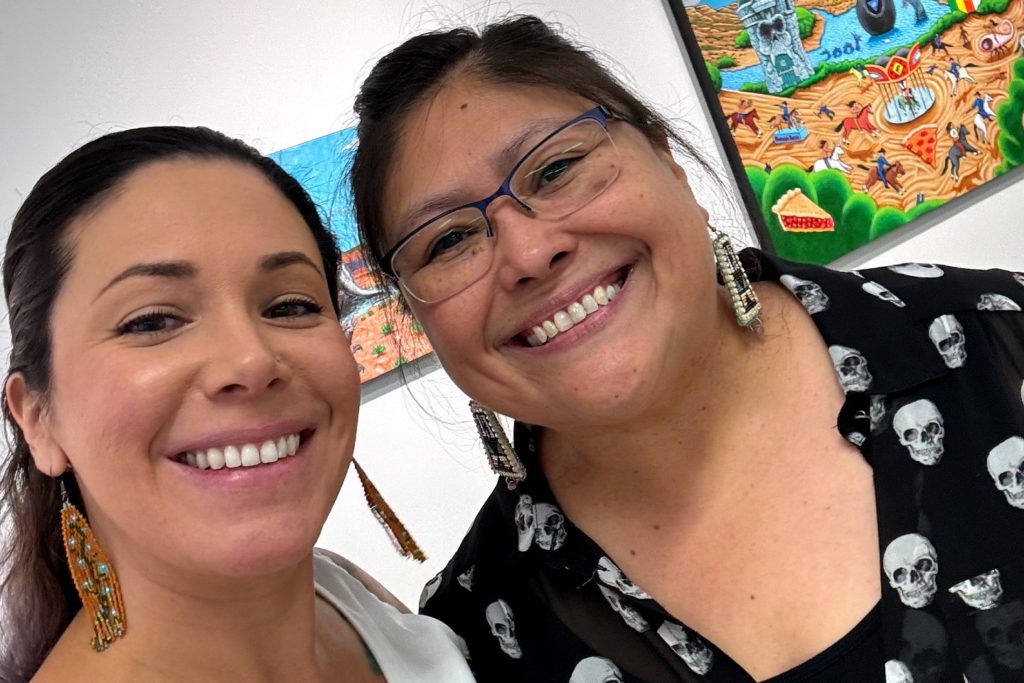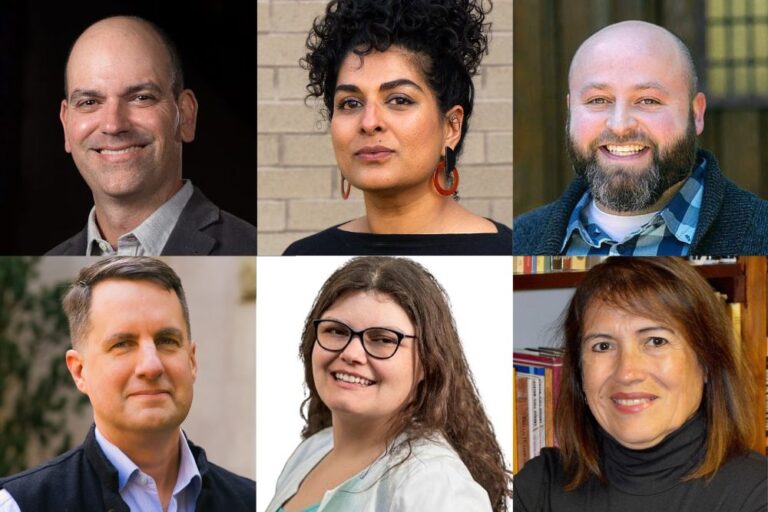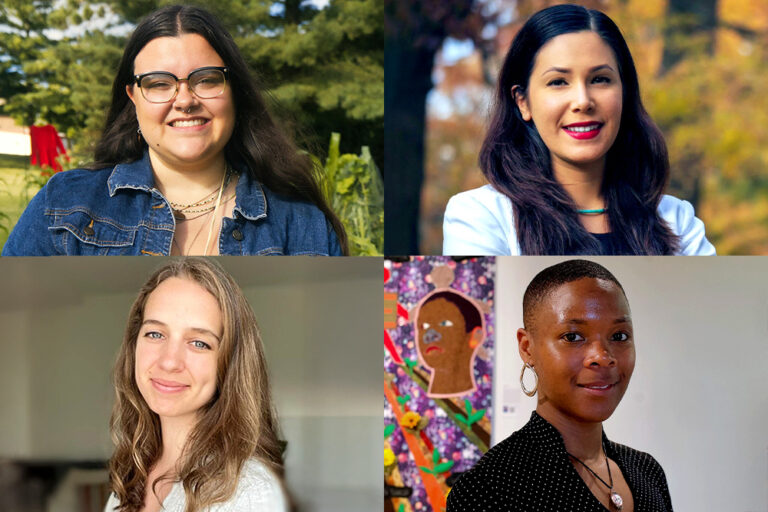A photo of a Star Wars stormtrooper that hangs in Blaire Morseau’s home epitomizes both her childhood passions and current research pursuits. The photo appears in a frame with a unique Southwest design, a favorite find bought from a Native artist when Morseau was a graduate student at the University of New Mexico.

Now an Assistant Professor in the Department of Religious Studies at Michigan State University and an inaugural 1855 Professor of Great Lakes Anishinaabe Knowledge, Spiritualities, and Cultural Practices, Morseau, who is a citizen of the Pokagon Band of Potawatomi Indians, was awarded the Newberry Consortium in American Indian and Indigenous Studies (NCAIS) long-term faculty fellowship to support her research, tracing the roots of Indigenous science fiction and futurism in America. This research is the focus of Morseau’s next book, tentatively titled “Beyond the Spectacle: Tracing the Roots of Indigenous Science Fiction and Futurism in America from the Archives to Contemporary Visions.”
“What makes Indigenous science fiction different from mainstream science fiction is that we’re relying on our own traditional knowledge systems as opposed to just Western science.”
During the 2024-2025 academic year, with support from the NCAIS fellowship, Morseau is exploring the Newberry Library’s Indigenous Studies collection. She is particularly interested in examining the creative work of futurity – specifically Native-authored comics, zines, and speculative literature and Native-led activism.
In addition to this archival work, Morseau plans to visit the repositories containing the papers of cultural anthropologist Alfred L. Kroeber (University of California at Berkeley), writer and professor of biochemistry Isaac Asimov (University of Maryland), and author Ursula K. Le Guin (University of Oregon) to better understand the possible Indigenous influences of their political and creative thinking.

“What makes Indigenous science fiction different from mainstream science fiction is that we’re relying on our own traditional knowledge systems as opposed to just Western science,” Morseau said. “For example, our vocabulary about colonization, which obviously didn’t work out so well for us, is different. And a lot of the ways in which the future was imagined was from the point of view of Euro-American societies that saw their advancement and their progression into the future, whether that was through descriptions of techno cityscapes or the colonization of Mars.
“How could those futures be alternatively imagined by people who weren’t originally part of those stories? There are Indigenous storytellers who write post-apocalyptic films or stories and traditional stories that, to us, would read as science fiction because they include things like alternate dimensions or people from the stars.”
A Place-Based Research Project
Beyond her archival research, Morseau plans to interview Chicago-based Indigenous artists and writers. Because Chicago has emerged as a breeding ground, of sorts, for Native futurisms, Morseau is positioning the city as the backdrop of her historical research – beginning with the 1893 World’s Fair in Chicago as the theoretical foundation for the project until the present day.
The World’s Columbian Exposition, also known as the 1893 Chicago World’s Fair, celebrated the 400th anniversary of Christopher Columbus arriving in the New World. The emphasis was on American progress and modernity with millions of people being introduced to new technological wonders like elevators, the Ferris wheel, the first voice recording, and more. Unfortunately, Morseau says Native Americans in their traditional regalia also were put on display and showcased as though they were archaic Neanderthals.

“This is what I tell my students is an anachronism – something that lives outside of the correct time,” Morseau said. “For example, if you were to look at a painting of the signing of the Declaration of Independence and someone’s wearing an Apple watch, it’s something that doesn’t belong. In the same sense, they were viewing Native societies as backwards, as of the past, which, of course, they were not living in the past. They were living in the present in their own ways. That’s how Native peoples were treated, as being from the past instead of the future.
“This started a whole tradition of science fiction, written by Europeans and Americans who see themselves as advanced. If Native peoples don’t belong in the present day, they certainly don’t belong in the future, right? But traditional and contemporary works of Indigenous speculative fiction intervene into that.”
Morseau is the co-director of Indigenous Chicago, a multifaceted project that explores the histories and present day of Native life in Chicago, which has long been home to diverse Indigenous peoples and continues to be home to vibrant Indigenous communities today.

More than five years in the making, Indigenous Chicago is a collaboration between the Newberry Library, Chicago American Indian Community, and the tribal nations that have ancestral ties to Chicago. It is a living project and archive that will continue to be added to in collaboration with Native communities.
The project includes a temporary exhibition, digital resources and interactive maps that reposition Chicago as Indigenous land and space, curriculum for high school social studies students, new oral histories of community members, and a series of public programs. The exhibition, titled Indigenous Chicago, opened Sept. 12, 2024, and runs through Jan. 4, 2025, at the Newberry Library. It showcases the dynamic and complex aspects of Native life in Chicago from the 17th century to the present.
“Mainstream society is ready for these other stories in the wake of nontraditional films and characters like Black Panther: Wakanda Forever and Echo, a Marvel Studio film that has a Native deaf woman as its main character. People are just hungry for these types of stories.”
According to Morseau, since 2008, Chicago also has become a hub for Native speculative fiction writers, or “Indigenerds,” who have produced Indigenous-made comic books, graphic novels, and other forms of science fiction, art, and literature. She said she believes the growth of Native publishing houses in Canada and the United States as well as the establishment of the Center for Native Futures in Chicago in 2023 are reasons behind the surge.
“Mainstream society is ready for these other stories in the wake of nontraditional films and characters like Black Panther: Wakanda Forever and Echo, a Marvel Studio film that has a Native deaf woman as its main character,” Morseau said. “People are just hungry for these types of stories.”
From Star Trek to Grass Roots Futurism
Morseau has always been drawn to science fiction and has fond memories of her mother watching episodes of Star Trek during the ‘90s and taking her to see sci-fi films.
“I started with fantasy,” she said. “I really liked Labyrinth and those kinds of movies. But then I started really getting into Star Wars, and my mom would take me to see things like Mission to Mars. That was my favorite movie forever. Now I realize it really isn’t that great of a movie.”

While “science fiction” is the genre most people are familiar with, Morseau generally uses the broader term “speculative fiction” since science or technology isn’t always involved in a particular work that considers the future. In other words, a significant portion of Native-made novels, film, artwork, or even political movements is speculative because it focuses on circumstances beyond our current moment or experiences.
“A large part of my work is not just escapist,” Morseau said. “It’s not just interpreting these really fun works of art and literature, but also looking at the ways that activism is a form of futurism.”
“A large part of my work is not just escapist. It’s not just interpreting these really fun works of art and literature, but also looking at the ways that activism is a form of futurism.”
Morseau points to grassroots organizations like Mother Earth Water Walkers and the NoDAPL movement as types of futurism because they work to imagine, inspire, and mobilize alternative ways of being or alternative futures, and science fiction does the same thing. The Mother Earth Water Walk is an Anishinaabe-led initiative where Water Walkers trek hundreds of miles around the Great Lakes each year to raise awareness about the need to protect the region’s water. The NoDAPL movement that took place in 2016-2017, considered to be the largest gathering of Indigenous tribes in over a century, was an effort to oppose construction of the Dakota Access Pipeline (DAPL) on sacred land and water of the Standing Rock Indian Reservation in North and South Dakota.

Morseau’s dissertation was on environmental movements in the Great Lakes region and how they represent a form of futurity. She earned both her Ph.D. and M.A. in Anthropology from the University of New Mexico and a B.A. in Anthropology from Rutgers University.
Shedding Light on Native Histories and Experiences
Morseau is one of two faculty members in the Department of Religious Studies to receive an inaugural 1855 Professorship. Created by MSU’s Office of the Provost and named for the year the university was founded, the 1855 Professorships aim to advance MSU’s Strategic and DEI (Diversity, Equity, and Inclusion) priorities by transforming the impact made on minoritized, marginalized, and underrepresented communities both on and off campus.
Since arriving at MSU in Fall 2023, in addition to her research and teaching, Morseau has worked on a digital humanities project at the MSU Digital Scholarship Lab, which involves uploading Potawatomi knowledge of star constellations onto a digital platform that can be accessible to Potawatomi people as well as astronomers and teachers.

Earlier this month, Morseau presented about Neshnabé Nengosêk Kenomagewen: Potawatomi Star Knowledge at the MSU Abrams Planetarium where she used the Sky Theater to identify culturally significant Potawatomi constellations while sharing relevant stories and discussing the importance of Indigenous traditional knowledge.
Morseau’s first monograph, titled Mapping Neshnabé Futurity: Celestial Currents of Sovereignty in Potawatomi Skies, Lands, and Waters, will be published in Spring 2025. The book explores how the Potawatomi people utilize celestial knowledge and practices to reclaim their sovereignty and envision a future rooted in Indigenous knowledge systems, particularly through the lens of their connection to the lands, skies, and waters of their traditional territories.
Last year, Morseau released an edited volume, titled As Sacred to Us: Simon Pokagon’s Birch Bark Stories in their Contexts, which features the collection of 19th– and early 20th-century birch bark books written by Potawatomi author Simon Pokagon. In addition to the stories themselves, the book, which was published by the Michigan State University Press, has several essays by other contributors that contextualize Pokagon’s work.

On Tuesday, Nov. 19, from 3 to 5 p.m. Moreseau and Ellie Mitchell, Indigenous Community Outreach Liaison for MSU’s Center for Language Teaching Advancement (CeLTA), will lead a beading workshop at MSU as part of the Native American Heritage Month events happening on campus. The workshop is for everyone, from those who are experienced to beginners who are looking to learn. The workshop will take place in the Urban Planning and Landscape Architecture Building, Room 105.
Following her nine-month NCAIS fellowship, Morseau says she’s “looking forward to coming back to teaching next year with a refreshed perspective” after having had the chance to read newer materials as part of the Newberry fellowship that she can share and teach with students.


